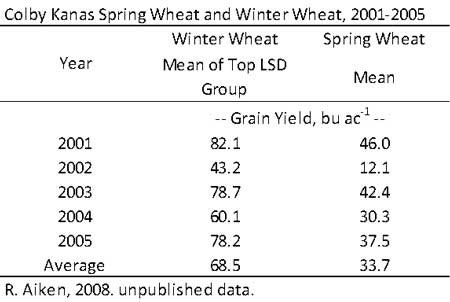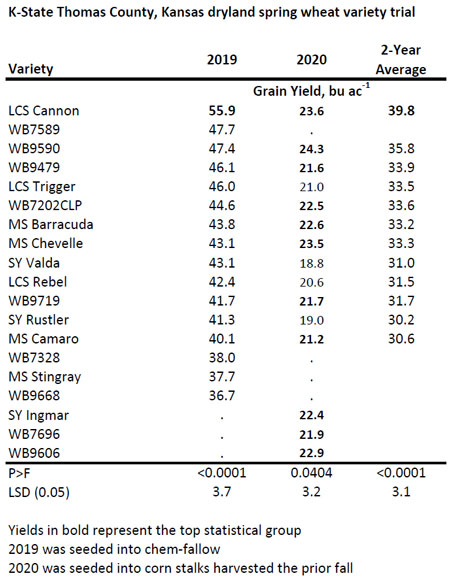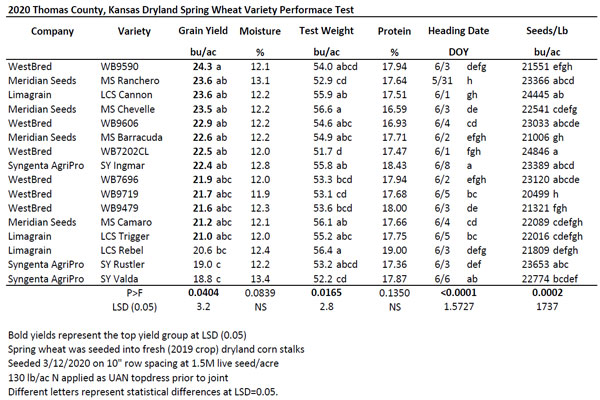Spring wheat is a cool-season grain crop that in adapted areas of production (typically the Northern Great Plains) usually produces a higher protein and higher quality grain for milling and baking purposes. Spring wheat can be produced in northwest Kansas and adjoining areas. Yields will be lower than summer fallow winter wheat. Grain quality will be an important component of marketability. The long-term ability to produce quality spring wheat in northwest Kansas, and its economic viability, has yet to be demonstrated.
Management
Traditionally, spring wheat has not been a recommended crop in northwest Kansas. However, if spring wheat is planted, the K-State recommendation is to plant from February 25 through March 15. Particular emphasis should be given to the ending date relative to the starting date for minimizing heat stress, which will be the yield limiting factor in most years. In research plots at Colby, dormant seeded spring wheat in December has shown to be viable in stand establishment. Seeding rates significantly higher than those typically used in winter wheat will be necessary due to the reduced window for initiating productive tillers. In addition, heat stress will be exceptionally detrimental to tillers of spring wheat as compared to winter wheat, making the density of main stems even more important to achieving yield potential.
K-State does not have any current data regarding appropriate seeding rates for spring wheat but limited experience would suggest 1.3 to 1.8 million seeds per acre to be an appropriate range. The first year of a seeding rate study was conducted at Colby in 2020 with rates ranging from 750k to 2M live seeds per acre. There was no response to seeding rate, however this was with yield levels in the 20-25 bu/ac range. With respect to nitrogen management, growers should consult the recommendations offered by North Dakota State University in the publication SF712, “Fertilizing Hard Red Spring Wheat and Durum”. Spring wheat will reach physiological maturity and be harvested slightly later than winter wheat in our region.
Experimental data on yield of spring wheat
Spring wheat has been evaluated at several points in time in northwest Kansas. From a historical context, during a 35-year study at Colby (1915-1950), spring wheat grown on fallow averaged slightly less than ½ of winter wheat grown (also on fallow). Additional research in the 1970’s demonstrated a similar relationship. More modern research was conducted in 2001 through 2005 in which spring wheat averaged 49% of winter wheat (Table 1).
Table 1. Summary of grain yields for spring wheat vs. winter wheat from 2001-2005 at Colby, KS.

In response to producers’ questions regarding spring wheat, spring wheat variety trials were conducted in northwest KS beginning in 2019. Table 2 shows individual year and across-years means for spring wheats evaluated at Colby, Kansas. There is a distinct difference in yields between the two years. The first year of the trial was seeded into chemical-fallow ground while the second year of the trial was seeded into fresh corn stalks harvested the prior fall. While adequate stands were attained in both years, the cooler temperatures during grain fill and increased soil moisture due to the previous fallow period resulted in greater yield potentials in 2019. Table 3 contains the full dataset for varieties evaluated in the 2020 trial. There was a very small range in yields, with most varieties producing yields that are statistically equivalent. Proteins in 2020 were quite high due to the high rate of N application for the yields that were achieved.
Table 2. Across-years yield performance for spring wheats evaluated at Colby, Kansas, 2019-2020.

Table 3. 2020 Thomas County Dryland Spring Wheat Performance Test Results.

Data would show a significant reduction in yield potential for spring wheat relative to winter wheat when both are grown on fallow. Yields are likely to be more similar when grown immediately following a row crop. However, it is important to note, yield is not the lone determining factor for the viability of the practice. Differences in cost structure and revenue could very well make spring wheat an economically feasible fallow alternative, provided that quality grain can be raised and marketed at a premium to winter wheat.
Marketing
Producers should be aware that hard red and hard white spring wheats are different market classes than hard red or hard white winter wheats. While small quantities are likely being blended off without notice, any concentration greater than 2% would be considered a mixing of classes that could result in the rejection of shipments. A local delivery point did exist in northwest Kansas in 2020 and has plans to receive spring wheat again in 2021. Additionally, a producer may have success using on-farm storage to allow proper segregation, time to perform necessary testing of grain quality, and then direct marketing to a mill.
Take home message
Spring wheat can be produced in this region. Producers should have marketing plans in place prior to production and manage the crop to ensure quality. Yields will likely be less relative to winter wheat due to heat stress during grain fill. However, there are still many unknowns regarding the production of spring wheat and its long-term viability in northwest Kansas and adjacent areas.
The spring wheat variety performance test results are available to view and download on the Northwest Area Agronomy website: www.northwest.ksu.edu/agronomy
Lucas Haag, Northwest Area Agronomist – Colby
lhaag@ksu.edu